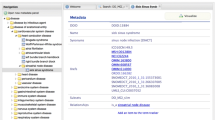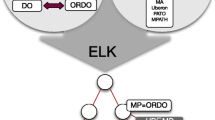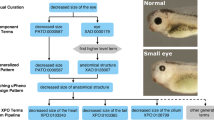Summary
The search for new mouse models of human disease has recently driven the funding of high throughput, large scale mutagenesis programmes throughout the world. As part of the attempt to deal with the data deluge resulting from these approaches together with existing hypothesis driven mouse genetics, there has been much discussion of the coding of mouse and human disease phenotypes in a way which lends itself to computer analysis, and the generation of new informatics tools. This chapter addresses current approaches to the development of a disease ontology or description framework, and critically assesses the requirements and potential solutions to the problems inherent in such an enterprise.
Access this chapter
Tax calculation will be finalised at checkout
Purchases are for personal use only
Preview
Unable to display preview. Download preview PDF.
Similar content being viewed by others
References
J. Auwerx, P. Avner, R. Baldock, A. Ballabio, R. Balling, M. Barbacid, A. Berns,A. Bradley, S. Brown, P. Carmeliet, P. Chambon, R. Cox, D.Davidson, K. Davies,D. Duboule, J. Forejt, F. Granucci, N. Hastie, M. H. de Angelis, I. Jackson, D. Kioussis,G. Kollias, M. Lathrop, U. Lendahl, M. Malumbres, H. von Melchner, W. Muller,J. Partanen, P. Ricciardi-Castagnoli, P. Rigby, B. Rosen, N. Rosenthal, B. Skarnes, A.F.Stewart, J. Thornton, G. Tocchini-Valentini, E. Wagner, W. Wahli, and W. Wurst. The european dimension for the mouse genome mutagenesis program. Nat Genet, 36:925–7,2004.
K. Baird, S. Davis, C.R. Antonescu, U.L. Harper, R.L. Walker, Y. Chen, A.A. Glatfelter,P.H. Duray P.S., and Meltzer. Gene expression profiling of human sarcomas: insights intosarcoma biology. Cancer Res, 65:9226–35, 2005.
J. Berman. Modern classification of neoplasms: reconciling differences between morphologicand molecular approaches. BMC Cancer, 5:100, 2005.
M.D. Breyer, E. Bottinger, F.C. Brosius, T.M. Coffman, A. Fogo, R.C. Harris, C.W.Heilig, and K. Sharma. Diabetic nephropathy: of mice and men. Adv Chronic Kidney Dis, 12:128–45, 2005.
S.D. Brown, P. Chambon, and M.H. de Angelis. EMPReSS: standardized phenotypescreens for functional annotation of the mouse genome. Nat Genet, 37:1155, 2005.
C. Darwin. The variation of animals and plants under domestication., volume 2. JamesMurray, London, 1875.
P.W. Derksen, X. Liu, F. Saridin, H. van der Gulden, J. Zevenhoven, B. Evers, J.R. vanBeijnum, A.W. Griffioen, J. Vink, P. Krimpenfort, J.L. Peterse, R.D. Cardiff, A. Berns,and J. Jonkers. Somatic inactivation of E-cadherin and p53 in mice leads to metastaticlobular mammary carcinoma through induction of anoikis resistance and angiogenesis.Cancer Cell, 10:437–49, 2006.
J. Eggenschwiler, T. Ludwig, P. Fisher, P.A. Leighton, S.M. Tilghman, and A. Efstratiadis. Mouse mutant embryos overexpressing IGF-II exhibit phenotypic features of theBeckwith-Wiedemann and Simpson-Golabi-Behmel syndromes. Genes Dev, 11:3128–42, 1997.
A.P. Feinberg. A genetic approach to cancer epigenetics. Cold Spring Harb Symp Quant Biol, 70:335–41, 2005.
G.V. Gkoutos, E.C. Green, A.M. Mallon, J.M. Hancock, and D. Davidson. Buildingmouse phenotype ontologies. Pac Symp Biocomput, pages 178–89, 2004.
G.V. Gkoutos, E.C. Green, A.M. Mallon, J.M. Hancock, and D. Davidson. Using ontologiesto describe mouse phenotypes. Genome Biol, 6(R8), 2005.
E.C. Green, G.V. Gkoutos, A.M. Mallon, and J.M. Hancock. EMPReSS: European mousephenotyping resource for standardized screens. Bioinformatics, 21(12):2930–1, Apr 12 2005. PMID: 15827082.
A. Hamosh, A.F. Scott, J.S. Amberger, C.A. Bocchini, and V.A. McKusick. OnlineMendelian Inheritance in Man (OMIM), a knowledgebase of human genes and geneticdisorders. Nucleic Acids Res, 33:D514–7, 2005.
A.T. Hattersley. Unlocking the secrets of the pancreatic beta cell: man and mouse providethe key. J Clin Invest, 114:314–6, 2004.
J. Kelso, J. Visagie, G. Theiler, A. Christoffels, S. Bardien, D. Smedley, D. Otgaar,G. Greyling, C.V. Jongeneel, M.I. McCarthy, T. Hide, and W. Hide. eVOC: a controlled vocabulary for unifying gene expression data. Genome Res, 13:1222–30, 2003.
W.K. Lam-Tse, A. Lernmark, and H.A. Drexhage. Animal models of endocrine/organspecificautoimmune diseases: do they really help us to understand human autoimmunity? Springer Semin Immunopathol, 24:297–321, 2002.
E. Melanitou. The autoimmune contrivance: genetics in the mouse model. Clin Immunol,117:195–206, 2005.
R. Meuwissen, S.C. Linn, R.I. Linnoila, J. Zevenhoven, W.J. Mooi, and A. Berns. Inductionof small cell lung cancer by somatic inactivation of both Trp53 and Rb1 in aconditional mouse model. Cancer Cell, 4:181–9, 2003.
J.H. Nadeau. Modifier genes in mice and humans. Nat Rev Genet, 2:165–74, 2001.
F. Neuhaus, P. Grenon, and B. Smith. A formal theory of substances, qualities, and universals.In A. Varzi and L. Vieu, editors, Formal Ontology in Information Systems (FOIS04),page 4959. IOS Press, 2004.
T.P. O’Connor and R.G. Crystal. Genetic medicines: treatment strategies for hereditarydisorders. Nat Rev Genet, 7:261–76, 2006.
College of American Pathologists. Systematized nomenclature of medicine (SNOMED),1976.
World Health Organization. Manual for international Classification of diseases and health related Problems. Geneva, Switzerland, 10th edition, 1992.
P.N. Schofield, J.B. Bard, C. Booth, J. Boniver, V. Covelli, P. Delvenne, M. Ellender,W. Engstrom, W. Goessner, M. Gruenberger, H. Hoefler, J. Hopewell, M. Mancuso,C. Mothersill, C.S. Potten, L. Quintanilla-Fend, B. Rozell, H. Sariola, J.P. Sundberg, andA. Ward. Pathbase: a database of mutant mouse pathology. Nucleic Acids Res, 32:D512–5, 2004.
B. Smith, A. Kumar, W. Ceusters, and C. Rosse. On carcinomas and other pathologicalentities. Comparative and Functional Genomics, 6:379–387, 2005.
C.L. Smith, C.A. Goldsmith, and J.T. Eppig. The mammalian phenotype ontology asa tool for annotating, analyzing and comparing phenotypic information. Genome Biol,6(R7), 2005.
A.K. Srivastava, M.C. Durmowicz, A.J. Hartung, J. Hudson, L.V. Ouzts, D.M. Donovan,C.Y. Cui, and D. Schlessinger. Ectodysplasin-A1 is sufficient to rescue both hair growthand sweat glands in tabby mice. Hum Mol Genet, 10:2973–81, 2001.
F.L. Sun, W.L. Dean, G. Kelsey, N.D. Allen, and W. Reik. Transactivation of Igf2 in amouse model of Beckwith-Wiedemann syndrome. Nature, 389:809–15, 1997.
W.J. Swanger and J.M. Roberts. p57KIP2 targeted disruption and Beckwith-Wiedemannsyndrome: is the inhibitor just a contributor? Bioessays, 19:839–42, 1997.
K. Takahashi, K. Nakayama, and Nakayama. Mice lacking a CDK inhibitor, p57Kip2,exhibit skeletal abnormalities and growth retardation. J Biochem (Tokyo), 127:73–83,2000.
L.K. Temple, R.S. McLeod, S. Gallinger, and J.G. Wright. Essays on science and society.defining disease in the genomics era. Science, 293:807–8, 2001.
Editor information
Rights and permissions
Copyright information
© 2008 Albert Burger, Duncan Davidson, Richard Baldock
About this chapter
Cite this chapter
Schofield, P.N., Rozell, B., Gkoutos, G.V. (2008). Towards a Disease Ontology. In: Burger, A., Davidson, D., Baldock, R. (eds) Anatomy Ontologies for Bioinformatics. Computational Biology, vol 6. Springer, London. https://doi.org/10.1007/978-1-84628-885-2_5
Download citation
DOI: https://doi.org/10.1007/978-1-84628-885-2_5
Publisher Name: Springer, London
Print ISBN: 978-1-84628-884-5
Online ISBN: 978-1-84628-885-2
eBook Packages: Computer ScienceComputer Science (R0)




